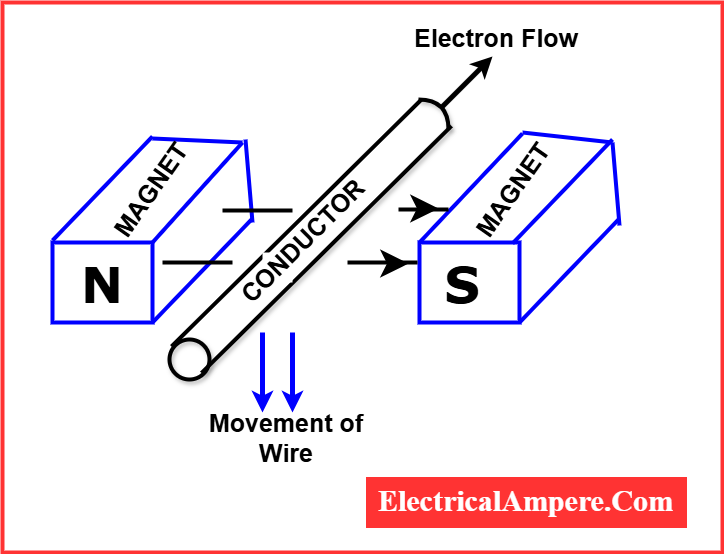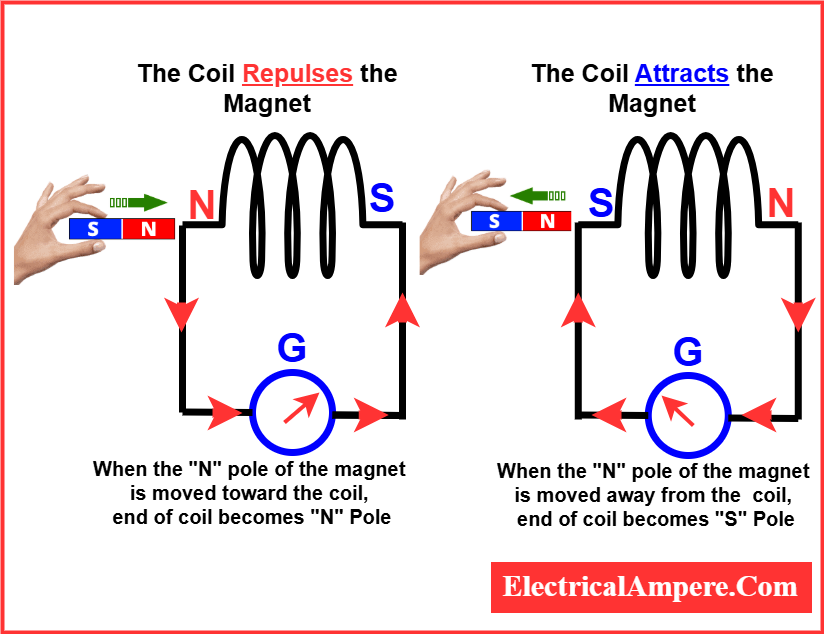Curious about how Lenz’s Law works? Discover its simple definition, real-life examples, formula, and how it explains current direction in transformers, generators, and induction cooktops — all in clear, easy-to-understand language.
Lenz’s Law Definition
Lenz’s Law, also known as the law of Lenz or Lenz’s law of induction, is a foundational concept in electromagnetism. It explains that when a magnetic flux through a circuit changes, the induced current always flows in a direction that opposes that change.
This principle, named after physicist Emil Lenz, is based on the law of conservation of energy and aligns with Newton’s third law of motion. It provides a reliable way to determine the direction of induced current in circuits influenced by varying magnetic fields.
Lenz’s Law Statement
The induced electromotive force (EMF) always generates a current whose magnetic field opposes the change in the original magnetic flux.
This formal statement of Lenz’s Law highlights its role in conserving energy by opposing magnetic changes that generate the current.
Lenz’s Law is Based on the Conservation of Energy
Lenz’s Law reflects the principle of conservation of energy in electromagnetic systems. When a change in magnetic flux induces an electric current, the direction of that current is such that it opposes the change that caused it. This opposition prevents energy from being created or destroyed spontaneously.
For example, if moving a magnet into a coil induces a current, that current generates its own magnetic field that resists the magnet’s motion. As a result, extra effort is needed to move the magnet, meaning energy is conserved through mechanical resistance.
Without this opposition, systems could generate continuous energy without input, violating fundamental physics. Thus, Lenz’s Law ensures that all electromagnetic induction processes obey the conservation of energy.
Lenz’s Law Formula
Lenz’s Law provides a mathematical way to calculate the induced electromotive force (EMF) generated due to a changing magnetic field. The formula is derived from Faraday’s Law of Electromagnetic Induction and includes a negative sign to represent opposition in accordance with Lenz’s principle.
EMF = -N d(Φ)/dt
Where:
- EMF = Induced electromotive force (volts)
- N = Number of turns in the coil
- Φ (Phi) = Magnetic flux (Webers)
- t = Time (seconds)

What Does the Negative Sign Indicate in Lenz Law?
The negative sign in Lenz’s Law formula indicates that the induced EMF generates a current that flows in a direction opposing the change in magnetic flux. It mathematically expresses Lenz’s principle of opposition and helps determine current direction during electromagnetic induction.
Lenz’s Law vs Faraday’s Law
Faraday’s Law and Lenz’s Law are closely related but serve different purposes in electromagnetic induction:
- Faraday’s Law tells us the magnitude of the induced EMF based on the rate of change of magnetic flux.
- Lenz’s Law tells us the direction of the induced current — always opposing the change that caused it.
In simple terms, Faraday quantifies, while Lenz qualifies.
Together, these laws offer a complete explanation of electromagnetic induction — with Faraday defining how much EMF is generated and Lenz describing which way the current flows in response.
Lenz’s Law Applications
Lenz’s Law has many practical uses in electrical and electronic systems:
- Induction Cooktops – Heating metal pans using opposing magnetic currents
- Electric Generators – Opposing motion when generating electricity
- Transformers – Ensuring energy conservation in alternating current systems
- Braking Systems – Eddy current brakes in trains and roller coasters
- Metal Detectors – Sensing change in magnetic fields
Lenz’s Law Experiment
Let’s explore three simple experiments to help understand the concept:

1. First Experiment – Magnet and Coil
Move a magnet towards a coil connected to a galvanometer. The needle deflects, showing an induced current. When the magnet is pulled away, the current direction reverses. This shows opposition to motion.
2. Second Experiment – Dropping a Magnet into a Copper Tube
The magnet falls slowly due to the opposing eddy currents created inside the non-magnetic copper tube. This is a classic demonstration of Lenz’s Law.
3. Third Experiment – Moving a Loop in a Magnetic Field
Sliding a loop of wire through a uniform magnetic field induces a current that opposes the entry and exit of the loop from the magnetic region.
Lenz’s Law Explained with Diagram and Example
The diagram below demonstrates how Lenz’s Law works using a simple magnet-and-coil setup:

- When a magnet approaches the coil, a current is induced that creates a magnetic field opposing the approaching magnet.
- When the magnet is withdrawn, the direction of induced current reverses to oppose the retreat.
This behavior can be observed using a galvanometer connected to the coil. The needle deflects differently based on the magnet’s motion, effectively demonstrating how Lenz’s Law governs the direction of induced current.
This visual example shows that the induced EMF and current always oppose the change in magnetic flux — exactly as described by the law.
Conclusion: Understanding Lenz’s Law in Electromagnetic Induction
Lenz’s Law is a fundamental concept in electromagnetic induction that explains how induced currents oppose changes in magnetic flux. It complements Faraday’s Law by providing the direction of the induced EMF. By applying the Lenz’s Law formula (EMF = -N dΦ/dt), engineers and students alike can understand how devices like transformers, generators, and induction heaters operate.
Whether you’re learning Lenz’s Law or its applications, this law plays a vital role in maintaining energy balance and explaining current direction in electromagnetic systems. With practical examples and real-world applications of Lenz’s Law, it’s clear why this principle of electromagnetic induction remains vital in the study of electromagnetism.”
FAQs on Lenz’s Law
It says that any induced current will flow in a direction to oppose the change that caused it.
The formula for Lenz’s Law is:
EMF = -N dΦ/dt,
where EMF is the induced electromotive force, N is the number of turns in the coil, Φ is the magnetic flux, and t is time. The negative sign indicates that the induced EMF opposes the change in magnetic flux, as per Lenz’s Law.
Yes, Lenz’s Law gives the direction of the EMF predicted by Faraday’s Law.
Lenz’s Law ensures that the induced current always flows in a direction that opposes the change in magnetic flux. This opposition prevents energy from being created out of nothing, maintaining balance in the system. In this way, the law aligns perfectly with the principle of conservation of energy.
→ For a detailed explanation, see the section: “Lenz’s Law is Based on the Conservation of Energy.”
It explains how energy is conserved in electromagnetic induction and guides design in electrical devices.
Induction cookers, electric braking, transformers, and metal detectors.
References:
Related Article: